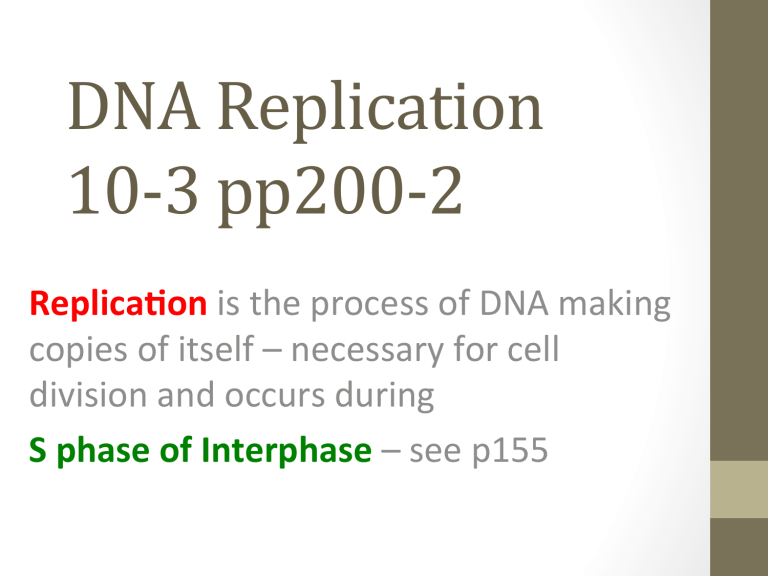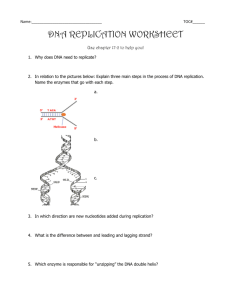DNA Replication 10-‐3 pp200-‐2

DNA Replication
10-‐3 pp200-‐2
Replica(on is the process of DNA making copies of itself – necessary for cell division and occurs during
S phase of Interphase – see p155
Steps/Parts of Replication:
• Loca(on:
• In the NUCLEUS
• When:
• During Interphase,
the S phase
Memories . . .
• What:
• DNA copies itself
Part 1 in EUKARYOTES
See Fig10-‐10 p201
1.
Enzyme breaks H-‐bonds along the helix – HELICASE
2.
The DNA molecule is opened at many places along
the length of the double helix
3.
Helicase breaks hydrogen bonds between N-‐bases
on complementary DNA strands
4. The Y-‐shape of the parPally opened DNA double helix
is called the REPLICATION FORK
h@ps://www.youtube.com/watch?v=OnuspQG0Jd0
Replication Part 2:
1.
DNA nucleoPdes will be added according to the base-‐pairing rules along each of the exposed parental DNA strands (A-‐T, C-‐G)
2.
Enzyme (to make “many” nucleoPde sequences),
DNA POLYMERASE does 4 things: a.
Adds nucleoPdes to exposed parent strands b.
Checks to make sure nitrogen bases properly match – A to T and C to G – “proof reads” c.
Forms hydrogen bonds between bases of each parent strand and each new strand d.
Forms covalent bonds between the phosphates and sugars of the nucleoPdes of each new strand
Polymerase Action
TEQMeP9GG6M
Replication Part 3:
1. NoPce the different direcPons of the strands in the
previous picture (new always form 5’ toward 3’)
a. The direcPon of replicaPon is conPnuous toward the
fork along the leading strand
b. . . . and is in segments that must later be joined away
from the fork along the lagging strand
c. The lagging strand fragments are joined by the
enzyme DNA LIGASE (liga = to bind together)
**** NOTE ****
DNA replication is considered
SEMI-‐CONSERVATIVE because following replication, each new daughter strand “conserves” one original parent strand to
partner with one new strand – old and new together
Replication Part 3:
That’s all folks!
Once the enPre length of DNA (millions of bases) has been replicated, the helicase and polymerases leave the strands and the two new daughter DNA double helix molecules each contain an original parent strand and one new strand
This all occurs early in Interphase S Phase in preparaPon for cell division (mitosis and meiosis).
Replication in
Prokaryotes
Because most have
circular DNA called
plasmids , the process is
similar but not the same
Mutations
DNA Polymerase proofreads the nucleoPdes during replicaPon, but somePmes a mistake gets by the
checking process.
If the sequence of nucleoPdes in the new daughter molecules is different from the original DNA parent
molecule, it is called a “mutaPon.”
Some mutaPons can be beneficial and help a species adapt to its environment beder than previous
generaPons = evolu(on by beneficial adaptaPons!
Some mutaPons are detrimental, causing cancer and malfuncPons that lead to death – they are lethal







